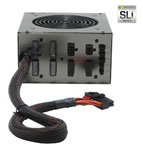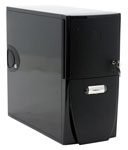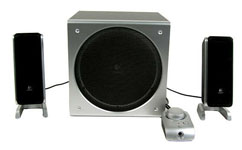Mid-Range Buyer's Guide, September 2005
by Jarred Walton on September 19, 2005 12:05 AM EST- Posted in
- Guides
Remaining Recommendations
We've covered the major components of the systems, and all that remains are the accessories. There isn't much new to say on the majority of these parts, and our Price Guides cover each area in more detail. Here are the rest of the components, and for most of them personal preference will play a large part in determining what you get. If you want higher quality speakers, you'll need to spend more money. A faster hard drive (or multiple hard drives) is definitely an option, but for most people it won't have a major impact - we generally prefer storage capacity and low noise levels over a small increase in HDD performance. Case, power supply, and optical storage choices round out the final components.
We have two lists of the remaining parts, one for the gaming configurations and the other for the office setups. We tried to balance the final system cost as much as possible, but the simple truth is that a good gaming/enthusiast setup requires more expensive parts than a business configuration. You can always downgrade some of the components to cheaper alternatives, but if we were building a computer for our own use, we'd rather save up for better quality than settle for lower cost.
Gaming Components:
Office Components:
Most of the choices should be pretty self-explanatory, so we just want to touch on the important areas. First, we've chosen to use a higher end power supply for the gaming configuration. Many people think that the modular power supplies are nice as they help to eliminate cable clutter, though some of the cables are a little stiff and can be difficult to route. The SunBeam 550W that we've chosen includes two PCIe power connectors, which would be required for an SLI configuration. (If you're running high-end components in an SLI setup, we'd think twice about using simple molex-to-PCIe adapters.) $86 for a power supply is a lot of money, but that's better than having random system crashes caused by exceeding the PSU load levels. Antec, OCZ, Enermax, and a few others also have some SLI-ready power supplies, though most cost upwards of $100 (and we'd avoid anything claiming SLI readiness that costs under $75).
Both setups use pretty low-end speaker arrangements. The Z-3e speakers sound good for the price, but they're not at the level of something like the Z-5500 or Klipsch, and true audiophiles would scoff at either of those "high end" choices that we just mentioned. If you're serious about audio quality, you probably already know more than what we typically cover in the Buyer's Guides. (The entire Logitech line of speakers is pretty reasonable if you're looking for other options. We've recommended them many times in the past, and this isn't really a change in recommendation so much as an alternative that you might consider.) We also stick with the integrated audio solutions for all of the systems, though the Karajan adapter of the DFI board certainly offers the best overall quality of the four boards. While there is a difference between integrated audio and discrete audio solutions, you'll need better speakers before it really begins to matter.
Our hard drive and optical drive selections are essentially a toss up. Our last Hard Drive Roundup showed that SATA 3.0Gbps drives were faster in some areas, NCQ could help out in certain tests as well, but there was no clear victor. All things being equal, we'll go for cost per GB, and for the dual-core systems, we'll also grab an NCQ enabled drive. Some people would rather have a better warranty like the 5-year Seagate and Western Digital Raptor or Caviar RE. If you ever need to use that warranty, though, you'll probably be pretty unhappy - the data on the drive is almost always more important than the drive itself. That's why a good backup strategy is important, and the DVDR drives that we've listed will get you started. We should also mention that firmware updates to the NEC 3540A and BenQ DW1640 drives have ironed out most of the media compatibility issues, so either drive is a good purchase.
We've covered the major components of the systems, and all that remains are the accessories. There isn't much new to say on the majority of these parts, and our Price Guides cover each area in more detail. Here are the rest of the components, and for most of them personal preference will play a large part in determining what you get. If you want higher quality speakers, you'll need to spend more money. A faster hard drive (or multiple hard drives) is definitely an option, but for most people it won't have a major impact - we generally prefer storage capacity and low noise levels over a small increase in HDD performance. Case, power supply, and optical storage choices round out the final components.
We have two lists of the remaining parts, one for the gaming configurations and the other for the office setups. We tried to balance the final system cost as much as possible, but the simple truth is that a good gaming/enthusiast setup requires more expensive parts than a business configuration. You can always downgrade some of the components to cheaper alternatives, but if we were building a computer for our own use, we'd rather save up for better quality than settle for lower cost.
 |
 |
 |
| Click images to enlarge. | ||
Gaming Components:
| Hard Drive: | Western Digital SATA II 160GB 7200RPM 8MB Caviar SE | $81 |
| Optical Drive: | BenQ DW1640 Black (OEM) | $43 |
| Case: | Cooler Master Cavalier 3 CAV-T03-UK | $76 |
| Power Supply: | SunBeam 550W NUUO SUNNU550-US-BK Modular PSU | $86 |
| Speakers: | Labtec ARENA 685 5.1 Speakers | $48 |
| Keyboard and Mouse: | Logitech Internet Pro Desktop | $23 |
 |
 |
 |
| Click images to enlarge. | ||
Office Components:
| Hard Drive: | Hitachi SATA 250GB 7200RPM 8MB Deskstar 7K250 NCQ | $120 |
| Optical Drive: | NEC 3540A Black (OEM) | $42 |
| Case and Power Supply: | Antec Sonata II + SmartPower 2.0 450W PSU | $115 |
| Speakers: | Logitech Z-3e 2.1 Speakers | $73 |
| Keyboard and Mouse: | Logitech Internet Pro Desktop | $23 |
Most of the choices should be pretty self-explanatory, so we just want to touch on the important areas. First, we've chosen to use a higher end power supply for the gaming configuration. Many people think that the modular power supplies are nice as they help to eliminate cable clutter, though some of the cables are a little stiff and can be difficult to route. The SunBeam 550W that we've chosen includes two PCIe power connectors, which would be required for an SLI configuration. (If you're running high-end components in an SLI setup, we'd think twice about using simple molex-to-PCIe adapters.) $86 for a power supply is a lot of money, but that's better than having random system crashes caused by exceeding the PSU load levels. Antec, OCZ, Enermax, and a few others also have some SLI-ready power supplies, though most cost upwards of $100 (and we'd avoid anything claiming SLI readiness that costs under $75).
Both setups use pretty low-end speaker arrangements. The Z-3e speakers sound good for the price, but they're not at the level of something like the Z-5500 or Klipsch, and true audiophiles would scoff at either of those "high end" choices that we just mentioned. If you're serious about audio quality, you probably already know more than what we typically cover in the Buyer's Guides. (The entire Logitech line of speakers is pretty reasonable if you're looking for other options. We've recommended them many times in the past, and this isn't really a change in recommendation so much as an alternative that you might consider.) We also stick with the integrated audio solutions for all of the systems, though the Karajan adapter of the DFI board certainly offers the best overall quality of the four boards. While there is a difference between integrated audio and discrete audio solutions, you'll need better speakers before it really begins to matter.
Our hard drive and optical drive selections are essentially a toss up. Our last Hard Drive Roundup showed that SATA 3.0Gbps drives were faster in some areas, NCQ could help out in certain tests as well, but there was no clear victor. All things being equal, we'll go for cost per GB, and for the dual-core systems, we'll also grab an NCQ enabled drive. Some people would rather have a better warranty like the 5-year Seagate and Western Digital Raptor or Caviar RE. If you ever need to use that warranty, though, you'll probably be pretty unhappy - the data on the drive is almost always more important than the drive itself. That's why a good backup strategy is important, and the DVDR drives that we've listed will get you started. We should also mention that firmware updates to the NEC 3540A and BenQ DW1640 drives have ironed out most of the media compatibility issues, so either drive is a good purchase.










56 Comments
View All Comments
GMAN003 - Friday, October 7, 2005 - link
First of all, Great guide Jarred! Because of your article I am now an AnandTech member for life! @$$kissing aside, here are some of my questions and suggestions for your article.1) Would you have noticed any significant speed gains by using different memory types such as DDR500 memory as recommend by DFI on their website? Yes, I know, its more expensive, but for the enthusiast on a budget, wouldn't overclocking memory be more up my ally especially for any future processor upgrades?
2) For future guides, you may want to consider a more comparable AMD vs Intel office processor. From reading other articles on the web, isn't the AMD64 3800 X2 processor more comparable to an Intel Celeron D 830 processor? In fact, in some benchmarks I have seen the 3800X2 be faster than the Intel Celeron D 840 processor?
3) I bought almost every part in your gaming system for a friend, except for the case/pwr supply and hard drive. Rolling the dice with an Aspire X-Navigator 500watt just for looks and a Raptor74GB for seek/write times. Any future posts on what you have been able to reach as "stable" OC levels and what your detailed bios settings are would be appreciated. From what I keep seeing around the web, most of my framerates in my games should be in the high 100's FPS. :-D Needless to say, I'm happy with the advice.
Again, thanks Jarred.
JarredWalton - Wednesday, October 26, 2005 - link
Heh - old post that I never saw. Glad you liked the article. For overclocking, there are many options. I wrote a "Venice Overclocking" article that covers many of the questions you asked. I'll be doing an Athlon X2 followup.I tried to make it clear in the article that the X2 was far superior in performance than the Pentium D. Price was a consideration, and if there were a cheaper X2 than the 3800+, I would have happily used it. Personally, I'd say the 3800+ actually outperforms even the Pentium D 840 in most benchmarks, and only heavy multitasking with four or more processes will favor the Pentium D 840EE. Once you look into overclocking, it really becomes no comparison. 2.6 GHz on the X2 3800+ compared to perhaps 3.2 or 3.4 GHz on the 820.
Anubis - Sunday, September 25, 2005 - link
especially of an office computer SLI is totally useless, you could save 100$ on the office comp and about 70 on the gameing one by going with a non SLI NF4 moboJarredWalton - Saturday, October 1, 2005 - link
SLI was *not* recommended for the office configurations. The choice of the X700 Pro as the GPU should be clear evidence of that.Crescent13 - Tuesday, September 20, 2005 - link
There are just a few minior things I would change...Jetway SLI motherboard instead of SLI-DR, it might be a bit better value for a mid-range gaming system.
I personally don't really like XFX, because they don't have that great of service and support, I would get an EVGA 7800GT, of course, that's just my opinion :)
I think I would get a hitachi 160GB SATAII hard drive, instead of western digital, hitachi has 8.5 MS seek time, western digital is 8.9 MS.
I would choose a forton source PSU, instead of SunBeam, for more stability.
I think the logitech x-530's would be a better choice than the labtec areana speakers.
this is all just my opinion, it's still a good guide :)
Googer - Tuesday, September 20, 2005 - link
If you are running a Venice Core Processor why would you run PC3200? Venice is perfectly capable of running DDR500 with out over clocking. AMD Said So.Pythias - Tuesday, September 20, 2005 - link
Because amd cpus benefit more form tight timings than bandwidth? http://forums.anandtech.com/messageview.aspx?catid...">http://forums.anandtech.com/messageview...amp;thre...SimonNZ - Tuesday, September 20, 2005 - link
because low latency ddr500 cost a small fortune, well mine did anyhow and most people buying in the mid range of the market arnt going 2 notice the difference....hell i dont:PPythias - Tuesday, September 20, 2005 - link
From what I gather you arent going to notice ddr500 over ddr400 whay spend more money?cryptonomicon - Tuesday, September 20, 2005 - link
uh.."With the motherboard and CPU that we've selected, though, you should be able to reach much higher speeds than 1.80GHz. 2.40GHz (267MHz CPU bus with the stock 9X CPU multiplier) is about as sure of an overclock as anything that we've seen."
no. no overclock is guaranteed and i am pretty surprised i am seeing an advocation for overclocking in this guide. i overclock myself but a brazen statement like that is just inviting hoardes of people to try the board, and not even know what they are getting into. OCing should come into the picture on most gaming hardware but in this guide its more like the OC is sort of an assumed part of the value. i really hate seeing 'sure' associated with 'overclock'. that's just another 100, 200, 1000 people at dfi-street.com that i have to troubleshoot for because they don't know what they are doing. allright well that's just a rant, nothing personal.